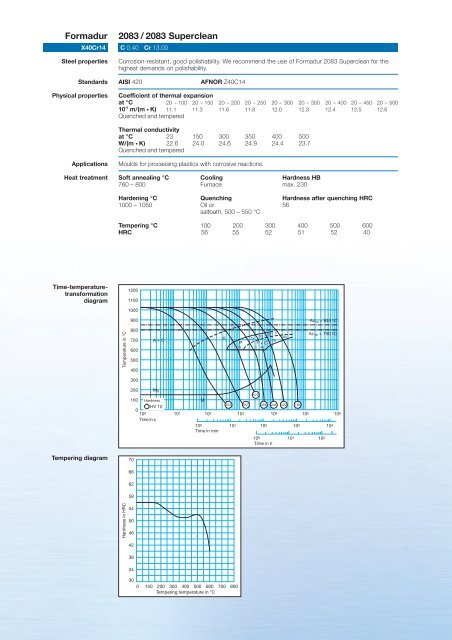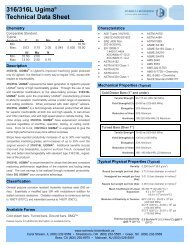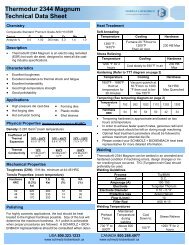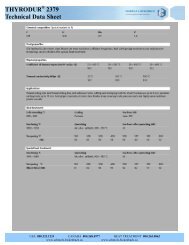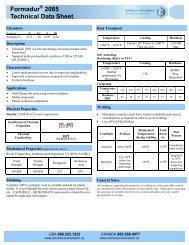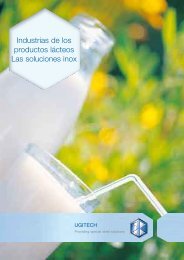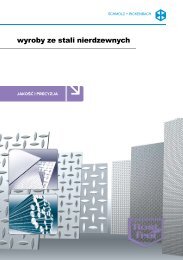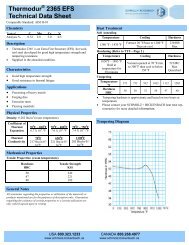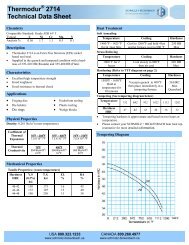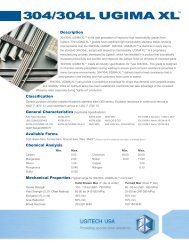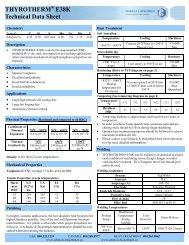Formadur - SCHMOLZ-BICKENBACH.US
Formadur - SCHMOLZ-BICKENBACH.US
Formadur - SCHMOLZ-BICKENBACH.US
You also want an ePaper? Increase the reach of your titles
YUMPU automatically turns print PDFs into web optimized ePapers that Google loves.
<strong>Formadur</strong><br />
X40Cr14<br />
Steel properties<br />
2083 / 2083 Superclean<br />
C 0.40 Cr 13.00<br />
Corrosion-resistant, good polishability. We recommend the use of <strong>Formadur</strong> 2083 Superclean for the<br />
highest demands on polishability.<br />
Standards<br />
AISI 420<br />
AFNOR Z40C14<br />
Physical properties<br />
Coefficient of thermal expansion<br />
at °C<br />
20 – 100 20 – 150 20 – 200 20 – 250 20 – 300 20 – 350 20 – 400 20 – 450 20 – 500<br />
10 -6 m/(m • K) 11.1 11.3 11.6 11.8 12.0 12.3 12.4 12.5 12.6<br />
Quenched and tempered<br />
Thermal conductivity<br />
at °C<br />
23 150 300 350 400 500<br />
W/(m • K) 22.6 24.0 24.6 24.9 24.4 23.7<br />
Quenched and tempered<br />
Applications<br />
Heat treatment<br />
Moulds for processing plastics with corrosive reactions.<br />
Soft annealing °C Cooling Hardness HB<br />
760 – 800 Furnace max. 230<br />
Hardening °C Quenching Hardness after quenching HRC<br />
1000 – 1050 Oil or 56<br />
saltbath, 500 – 550 °C<br />
Tempering °C 100 200 300 400 500 600<br />
HRC 56 55 52 51 52 40<br />
Time-temperaturetransformation<br />
diagram<br />
1200<br />
1100<br />
1000<br />
900<br />
Ac 1e = 845 C<br />
Temperature in °C<br />
800<br />
700<br />
600<br />
500<br />
400<br />
A + C<br />
K<br />
5<br />
25<br />
35<br />
35<br />
75<br />
P F + C<br />
15 5 40<br />
95<br />
Ac 1b = 790 C<br />
300<br />
200 M S<br />
579<br />
100 Hardness<br />
M<br />
HV 10<br />
672 657 456 244 220 193<br />
0<br />
10 0 10 1 10 2 10 3 10 4 10 5 10 6<br />
Time in s<br />
100 101 102 103 104<br />
Time in min<br />
10 0 10 1 10 2<br />
Time in h<br />
Tempering diagram<br />
70<br />
66<br />
62<br />
58<br />
Hardness in HRC<br />
54<br />
50<br />
46<br />
42<br />
38<br />
34<br />
30<br />
0 100 200 300 400 500 600 700 800<br />
Tempering temperature in °C
<strong>Formadur</strong><br />
X33CrS16<br />
Steel properties<br />
Standards<br />
Applications<br />
Heat treatment<br />
2085<br />
C 0.33 Cr 16.00 S 0.05 Ni 0.50<br />
Pre-hardened corrosion-resistant mould frame steel, hardness in as-delivered condition of 280 to 325 HB.<br />
Improved machinability in comparison to <strong>Formadur</strong> 2316.<br />
AISI ~420FM<br />
Mould frames, components, plastic moulds.<br />
Soft annealing °C Cooling Hardness HB<br />
850 – 880 Furnace max. 230<br />
Hardening °C Quenching Hardness after quenching HRC<br />
1000 – 1050 Oil 48<br />
Tempering °C 100 200 300 400 450 500 550 600<br />
HRC 48 48 47 46 47 47 36 30<br />
Time-temperaturetransformation<br />
diagram<br />
1200<br />
1100<br />
1000<br />
900<br />
Ac 1e<br />
Temperature in °C<br />
800<br />
700<br />
600<br />
500<br />
400<br />
A + K<br />
K<br />
P<br />
3<br />
1 3<br />
Ac 1b<br />
300<br />
200<br />
M S<br />
100 Hardness<br />
M<br />
585 566 585 585 579 572 542 450 380 279<br />
HV 10<br />
0<br />
10 0 10 1 10 2 10 3 10 4 10 5 106<br />
Time in s<br />
10 0 10 1 10 2 10 3 10 4<br />
Time in min<br />
10 0 10 1 10 2<br />
Time in h<br />
Tempering diagram<br />
70<br />
66<br />
62<br />
58<br />
Hardness in HRC<br />
54<br />
50<br />
46<br />
42<br />
38<br />
34<br />
30<br />
0 100 200 300 400 500 600 700 800<br />
Tempering temperature in °C
<strong>Formadur</strong> 2162<br />
21MnCr5<br />
C 0.21 Mn 1.30 Cr 1.20<br />
Steel properties<br />
Standards<br />
Physical properties<br />
Case hardening steel, good polishability, suitable for cold hobbing.<br />
AISI ~P2<br />
Coefficient of thermal expansion<br />
at °C 20 – 100 20 – 200 20 – 300 20 – 400 20 – 500 20 – 600 20 – 700<br />
10 -6 m/(m • K) 12.2 12.9 13.5 13.9 14.2 14.5 14.8<br />
Thermal conductivity<br />
at °C 20 350 700<br />
W/(m • K) 39.5 36.5 33.5<br />
Applications<br />
Heat treatment<br />
Mirror-finished plastic moulds and guide pins.<br />
Soft annealing °C Cooling Hardness HB<br />
670 – 710 Furnace max. 210<br />
Carburizing °C Intermediate Hardening °C Quenching Surface hardness<br />
annealing °C<br />
after quenching HRC<br />
870 – 900 620 – 650 810 – 840 Oil or saltbath, 62<br />
180 – 220 °C<br />
Tempering °C 100 200 300 400 500 600<br />
HRC 61 60 57 54 50 48<br />
Time-temperaturetransformation<br />
diagram<br />
1200<br />
1100<br />
1000<br />
Temperature in °C<br />
900<br />
800<br />
Ac 3<br />
Ac 1<br />
65<br />
700<br />
60 60 60 60<br />
60<br />
F<br />
10 25 35<br />
600<br />
40 P 4040 40 40 35<br />
A<br />
50<br />
500<br />
M B<br />
S<br />
50<br />
87<br />
400<br />
80 65<br />
60<br />
55<br />
300<br />
M<br />
45<br />
15<br />
200<br />
100 Hardness<br />
171<br />
HV 10<br />
405 342 302 274 253 238 212 187 160 182 162 153<br />
0<br />
10 0 10 1 10 2 10 3 10 4 10 5 10 6<br />
Time in s<br />
100 101 102 103 104<br />
Time in min<br />
100 101 102<br />
Time in h<br />
Tempering diagram<br />
70<br />
66<br />
62<br />
58<br />
Hardness in HRC<br />
54<br />
50<br />
46<br />
42<br />
38<br />
34<br />
30<br />
0 100 200 300 400 500 600 700 800<br />
Tempering temperature in °C
<strong>Formadur</strong><br />
(X37Cr13)<br />
Steel properties<br />
Physical properties<br />
2190 Superclean<br />
C 0.37 Si 0.90 Mn 0.50 Cr 13.6 V 0.30<br />
Corrosion-resistant, very good polishability.<br />
Coefficient of thermal expansion<br />
at °C<br />
20 – 100 20 – 150 20 – 200 20 – 250 20 – 300 20 – 350 20 – 400 20 – 450 20 – 500<br />
10 -6 m/(m • K) 10.7 11.0 11.2 11.5 11.7 11.9 12.1 12.3 12.4<br />
Quenched and tempered<br />
Thermal conductivity<br />
at °C<br />
23 150 300 350 400 500<br />
W/(m • K) 21.5 23.2 23.9 24.3 24.2 24.0<br />
Quenched and tempered<br />
Applications<br />
Heat treatment<br />
Moulds for processing of corrosive plastics.<br />
Soft annealing °C Cooling Hardness HB<br />
760 – 800 Furnace max. 230<br />
Hardening °C Quenching Hardness after quenching HRC<br />
1000 – 1050 Oil or 56<br />
saltbath, 500 – 550 °C<br />
Tempering °C 100 200 300 400 500 600<br />
HRC 56 55 52 51 52 40<br />
Tempering diagram<br />
70<br />
66<br />
62<br />
58<br />
Hardness in HRC<br />
54<br />
50<br />
46<br />
42<br />
38<br />
34<br />
Reference numbers<br />
in brackets are not<br />
standardized in EN ISO4957.<br />
30<br />
0 100 200 300 400 500 600 700 800<br />
Tempering temperature in °C
<strong>Formadur</strong> 2311<br />
40CrMnMo7 C 0.40 0,35 Mn Si 0,80 1.50 Cr Cr5,00 1.90 Mo1,00 0.20 V 0,85<br />
Steel properties<br />
Standards<br />
Physical properties<br />
Pre-hardened plastic mould steel, hardness in as-delivered condition 280 to 325 HB. Good machinability,<br />
suitable for texturing, better polishability than <strong>Formadur</strong> 2312.<br />
AISI P20<br />
Coefficient of thermal expansion<br />
at °C<br />
20 – 100 20 – 150 20 – 200 20 – 250 20 – 300 20 – 350 20 – 400 20 – 450 20 – 500<br />
10 -6 m/(m • K) 12.6 12.8 13.0 13.3 13.5 13.7 13.9 14.1 14.3<br />
Quenched and tempered<br />
Thermal conductivity<br />
at °C<br />
23 150 300 350 400 500<br />
W/(m • K) 32.5 32.9 31.3 30.2 29.5 27.4<br />
Quenched and tempered<br />
Applications<br />
Heat treatment<br />
Plastic moulds, mould frames for plastic moulds and pressure casting moulds and recipient sleeves.<br />
Soft annealing °C Cooling Hardness HB<br />
710 – 740 Furnace max. 235<br />
Hardening °C Quenching Hardness after quenching HRC<br />
840 – 870 Oil or 51<br />
saltbath, 180 – 220 °C<br />
Tempering °C 100 200 300 400 500 600 700<br />
HRC 51 50 48 46 42 36 28<br />
Time-temperaturetransformation<br />
diagram<br />
1200<br />
1100<br />
1000<br />
Temperature in °C<br />
900<br />
Ac 1e<br />
800<br />
700<br />
Ac<br />
100<br />
1b<br />
A + C<br />
100<br />
P<br />
600<br />
20<br />
3<br />
500<br />
400<br />
300<br />
M S<br />
B<br />
3<br />
45<br />
200<br />
60<br />
M<br />
95<br />
100 Hardness<br />
HV 10<br />
681 673 673 642 642 572 572 442 274 236<br />
0<br />
10 0 10 1 10 2 10 3 10 4 10 5 10 6<br />
Time in s<br />
10 0 10 1 10 2 10 3 10 4<br />
Time in min<br />
10 0 10 1 10 2<br />
Time in h<br />
Tempering diagram<br />
70<br />
66<br />
62<br />
58<br />
Hardness in HRC<br />
54<br />
50<br />
46<br />
42<br />
38<br />
34<br />
30<br />
0 100 200 300 400 500 600 700 800<br />
Tempering temperature in °C
<strong>Formadur</strong><br />
40CrMnMoS8-6 1)<br />
Steel properties<br />
Standards<br />
Physical properties<br />
2312<br />
C 0.40 Si 0.35 Mn 1.50 Cr 1.90 Mo 0.20 S 0.05<br />
Quenched and tempered plastic mould steel with a hardness in as-delivered condition of 280 to 325 HB.<br />
Improved machinability in comparison with <strong>Formadur</strong> 2311. Polishable.<br />
AISI P20+S<br />
Coefficient of thermal expansion<br />
at °C 20 – 100 20 – 200 20 – 300<br />
10 -6 m/(m • K) Annealed 12.5 13.4 13.9<br />
10 -6 m/(m • K) Quenched and tempered 12.3 13.0 13.7<br />
Thermal conductivity<br />
at °C 100 150 200 250 300<br />
W/(m • K) Annealed 40.2 40.9 40.3 40.0 39.0<br />
W/(m • K) Quenched and tempered 39.8 40.4 40.4 39.9 39.0<br />
Applications<br />
Heat treatment<br />
Plastic moulds, mould frames for plastic and pressure casting moulds, recipient sleeves, brake dies.<br />
Soft annealing °C Cooling Hardness HB<br />
710 – 740 Furnace max. 235<br />
Stress-relief annealing °C Stress-relief annealing °C Cooling<br />
(Annealed)<br />
(Quenched and tempered)<br />
approx. 600 approx. 30 – 50 under tempering temperature Furnace<br />
Hardening °C Quenching Hardness after quenching HRC<br />
840 – 870 Oil or 51<br />
saltbath, 180 – 220 °C<br />
Tempering °C 100 200 300 400 500 600 700<br />
HRC 51 50 48 46 42 36 28<br />
Time-temperaturetransformation<br />
diagram<br />
1200<br />
1100<br />
1000<br />
Temperature in ° C<br />
900<br />
Ac 1e<br />
800<br />
700<br />
Ac<br />
100<br />
1b<br />
A + C<br />
100<br />
P<br />
600<br />
20<br />
3<br />
500<br />
400<br />
300<br />
M S<br />
B<br />
3<br />
45<br />
200<br />
60<br />
M<br />
95<br />
100 Hardness<br />
HV 10<br />
681 673 673 642 642 572 572 442 274 236<br />
0<br />
10 0 10 1 10 2 10 3 10 4 10 5 10 6<br />
Time in s<br />
100 101 102 103 104<br />
Time in min<br />
10 0 10 1 10 2<br />
Time in h<br />
Tempering diagram<br />
70<br />
66<br />
62<br />
58<br />
Hardness in HRC<br />
54<br />
50<br />
46<br />
42<br />
38<br />
34<br />
1)<br />
S can be raised between<br />
0.05 and 0.1 % whereas<br />
Ni can be left out completely.<br />
30<br />
0 100 200 300 400 500 600 700 800<br />
Tempering temperature in ° C
<strong>Formadur</strong><br />
X38CrMo16<br />
Steel properties<br />
Standards<br />
Physical properties<br />
2316 / 2316 Superclean<br />
C 0.36 Cr 16.00 Mo 1.20<br />
Increased corrosion resistance in comparison to <strong>Formadur</strong> 2083, good polishability. Usually this steel grade<br />
is supplied in a quenched and tempered condition with a working hardness of approx. 300 HB.<br />
AISI 420mod<br />
Coefficient of thermal expansion<br />
at °C<br />
20 – 100 20 – 150 20 – 200 20 – 250 20 – 300 20 – 350 20 – 400 20 – 450 20 – 500<br />
10 -6 m/(m • K) 10.5 10.7 10.8 10.9 11.1 11.3 11.5 11.6 11.7<br />
Quenched and tempered<br />
Thermal conductivity<br />
at °C<br />
23 150 300 350 400 500<br />
W/(m • K) 23.5 24.2 24.3 24.4 24.1 23.2<br />
Quenched and tempered<br />
Applications<br />
Heat treatment<br />
Moulds for processing plastics with corrosive reactions.<br />
Soft annealing °C Cooling Hardness HB<br />
760 – 800 Furnace max. 230<br />
Hardening °C Quenching Hardness after quenching HRC<br />
1020 – 1050 Oil or 49<br />
saltbath, 500 – 550 °C<br />
Tempering °C 100 200 300 400 500 600<br />
HRC 49 47 46 46 47 32<br />
Time-temperaturetransformation<br />
diagram<br />
1200<br />
1100<br />
1000<br />
900<br />
Ac 1e<br />
Temperature in °C<br />
800<br />
700<br />
600<br />
500<br />
400<br />
A + C<br />
F + C<br />
Ac 1b<br />
300<br />
200<br />
100<br />
M S<br />
M<br />
199<br />
468<br />
Hardness<br />
HV 10<br />
620 620 627 634 530 542 514 317 180 182<br />
0<br />
100 101 102 103 104 105 10 6<br />
Time in s<br />
10 0 10 1 10 2 10 3 10 4<br />
Time in min<br />
10 0 10 1 10 2<br />
Time in h<br />
Tempering diagram<br />
70<br />
66<br />
62<br />
58<br />
Hardness in HRC<br />
54<br />
50<br />
46<br />
42<br />
38<br />
34<br />
30<br />
0 100 200 300 400 500 600 700 800<br />
Tempering temperature in °C
<strong>Formadur</strong><br />
X91CrMoV18<br />
Steel properties<br />
Physical properties<br />
2361<br />
C 0.90 Si < 1.00 Cr 18.00 Mo 1.00 V 0.10<br />
Corrosion-resistant steel for plastic moulding characterized by a very good wear resistance.<br />
Coefficient of thermal expansion<br />
at °C 20 – 100 20 – 200 20 – 300 20 – 400<br />
10 -6 m/(m • K) 10.5 11.0 11.0 12.0<br />
Thermal conductivity<br />
at °C 20<br />
W/(m • K) 29<br />
Applications<br />
Heat treatment<br />
Plastic moulds, injection nozzles, valve components and ball bearings.<br />
Soft annealing °C Cooling Hardness HB<br />
800 – 850 Slow, e.g. furnace max. 265<br />
Hardening °C Quenching Hardness after quenching HRC<br />
1000 – 1050 Oil 59<br />
Tempering °C 100 200 300 400 500 550 600<br />
HRC 58 56 54 54 54 50 40<br />
Tempering diagram<br />
70<br />
66<br />
62<br />
58<br />
Hardness in HRC<br />
54<br />
50<br />
46<br />
42<br />
38<br />
34<br />
30<br />
0 100 200 300 400 500 600 700 800<br />
Tempering temperature in °C
<strong>Formadur</strong> 2711<br />
54NiCrMoV6<br />
C 0.55 Cr 1.10 Ni 1.70 Mo 0.50 V 0.10<br />
Steel properties<br />
Standards<br />
Physical properties<br />
Pre-hardened plastic mould steel, hardness in as-delivered condition 355 to 400 HB (square, flat) and 370 –<br />
410 HB (round). Increased compressive strength in comparison to <strong>Formadur</strong> 2738, good polishability.<br />
AISI ~L6<br />
Coefficient of thermal expansion<br />
at °C<br />
20 – 100 20 – 150 20 – 200 20 – 250 20 – 300 20 – 350 20 – 400 20 – 450 20 – 500<br />
10 -6 m/(m • K) 12.2 12.5 12.7 13.0 13.3 13.5 13.8 13.9 14.1<br />
Quenched and tempered<br />
Thermal conductivity<br />
at °C<br />
23 150 300 350 400 500<br />
W/(m • K) 30.5 32.1 30.8 29.6 28.7 26.5<br />
Quenched and tempered<br />
Applications<br />
Heat treatment<br />
Plastic moulds with increased demands on compression strength and wear resistance.<br />
Soft annealing °C Cooling Hardness H<br />
650 – 700 Furnace Max. 240<br />
Hardening °C Quenching Hardness after quenching HRC<br />
830 – 870 Air or oil 57<br />
Tempering °C 100 200 300 400 450 500 550 600 650<br />
HRC 56 54 51 47 44 42 39 36 30<br />
Time-temperaturetransformation<br />
diagram<br />
1200<br />
1100<br />
1000<br />
cooling curves for the core of round bars with<br />
50, 100 and 200 mm dia. on oil hardening.<br />
Temperature in °C<br />
900<br />
800<br />
Ac 1e (0.4 K/min)<br />
Ac 1b (0.4 K/min)<br />
700<br />
P<br />
100<br />
80<br />
600<br />
2 15<br />
20<br />
A + C<br />
5 2.5 1.25<br />
0.10 0.38 1.1 2.2 3.1 6.2 s · 10 -2<br />
500<br />
0.4 K/min<br />
400<br />
50<br />
100 200 mm dia.<br />
M<br />
B<br />
S<br />
300<br />
2<br />
50<br />
5 45<br />
80<br />
200<br />
98<br />
Hardness<br />
98 85 20 Bainite in %<br />
HV 10<br />
M<br />
100<br />
795 815 766 766 715 613 430 366 354 323 257 232<br />
0<br />
100 101 102 103 104 105 10 6<br />
Time in s<br />
10 0 10 1 10 2 10 3 10 4<br />
Time in min<br />
10 0 10 1 10 2<br />
Time in h<br />
Tempering diagram<br />
70<br />
66<br />
62<br />
58<br />
Hardness in HRC<br />
54<br />
50<br />
46<br />
42<br />
38<br />
34<br />
30<br />
0 100 200 300 400 500 600 700 800<br />
Tempering temperature in °C
<strong>Formadur</strong><br />
40CrMnNiMo8-6-4<br />
Steel properties<br />
Standards<br />
Physical properties<br />
2738<br />
C 0.40 Mn 1.50 Cr 1.90 Ni 1.00 Mo 0.20<br />
Pre-hardened plastic mould steel, hardness in as-delivered condition 280 to 325 HB. Good machinability,<br />
suitable for texturing, improved through hardening in comparison to <strong>Formadur</strong> 2711, good polishability.<br />
AISI P20+Ni<br />
Coefficient of thermal expansion<br />
at °C 20 – 100 20 – 200 20 – 300 20 – 400 20 – 500 20 – 600 20 – 700<br />
10 -6 m/(m • K) 11.1 12.9 13.4 13.8 14.2 14.6 14.9<br />
Thermal conductivity<br />
at °C 20 350 700<br />
W/(m • K) 34.5 33.5 32.0<br />
Applications<br />
Heat treatment<br />
Large plastic moulds with deep engravings and intensive impacts on the core. <strong>Formadur</strong> 2738 is the logical<br />
development of <strong>Formadur</strong> 2311, a pre-hardened plastic mould steel for use in large moulds, which also<br />
have to display high core strength. The additional nickel content of 1 % increases through hardening.<br />
<strong>Formadur</strong> 2738 ia a micro-alloyed, vacuum-degassed steel with the following excellent features:<br />
good machinability, outstanding polishability, good texturing properties.<br />
Soft annealing °C Cooling Hardness HB<br />
710 – 740 Furnace max. 235<br />
Hardening °C Quenching Hardness after quenching HRC<br />
840 – 870 Polymer or oil 51<br />
Tempering °C 100 200 300 400 500 600 700<br />
HRC 51 50 48 46 42 39 28<br />
Time-temperaturetransformation<br />
diagram<br />
1200<br />
1100<br />
1000<br />
900<br />
Temperature in °C<br />
800<br />
700<br />
Ac 1e<br />
Ac 1b<br />
99<br />
600<br />
P 40<br />
1<br />
A + C<br />
5<br />
500<br />
400<br />
M S<br />
B<br />
300<br />
3<br />
10 70<br />
94 93 59 1<br />
M<br />
200<br />
Hardness<br />
100<br />
HV 10 631 572 563 539 440 380 378 306 224<br />
0<br />
10 0 10 1 10 2 10 3 10 4 10 5 10 6<br />
Time in s<br />
100 101 102 103 104<br />
Time in min<br />
10 0 10 1 10 2<br />
Time in h<br />
Tempering diagram<br />
70<br />
66<br />
62<br />
58<br />
Hardness in HRC<br />
54<br />
50<br />
46<br />
42<br />
38<br />
34<br />
30<br />
0 100 200 300 400 500 600 700 800<br />
Tempering temperature in °C
<strong>Formadur</strong><br />
(X19NiCrMo4)<br />
Steel properties<br />
Standards<br />
Physical properties<br />
2764<br />
C 0.19 Cr 1.30 Mo 0.20 Ni 4.10<br />
Case-hardening steel, high core strength, good polishability.<br />
AISI ~P21<br />
Coefficient of thermal expansion<br />
at °C 20 – 100 20 – 200 20 – 300 20 – 400<br />
10 -6 m/(m • K) 12.1 13.0 13.1 13.5<br />
Thermal conductivity<br />
at °C 20 350 700<br />
W/(m • K) 33.5 32.5 32.0<br />
Applications<br />
Heat treatment<br />
Highly stressed plastic moulds, tool holders for cutter picks.<br />
Soft annealing °C Cooling Hardness HB<br />
620 – 660 Furnace Max. 250<br />
Stress-relief annealing °C Cooling<br />
600 Furnace<br />
Carburizing °C Intermediate Hardening °C Quenching Hardness after<br />
annealing °C<br />
quenching HRC<br />
860 – 890 600 – 630 780 – 810 Oil or saltbath, 62<br />
180 – 220 °C<br />
860 – 890 600 – 630 800 – 830 Air 56<br />
Tempering °C 100 200 300 400 500 600<br />
after oil hardening HRC 62 60 58 56 52 49<br />
after air hardening HRC 56 55 53 51 48 45<br />
Time-temperaturetransformation<br />
diagram<br />
1200<br />
1100<br />
1000<br />
Temperature in o C<br />
900<br />
800<br />
Ac 3 (0.4 K/min)<br />
700<br />
Ac 1 (0.4 K/min)<br />
600<br />
2 5 10 17 F 30 35<br />
P<br />
A<br />
1 3 6 15<br />
23<br />
0.14 0.38 1.0 1.5 2.3 6.3<br />
20 10 5<br />
500<br />
2.5 K/min 0.4 K/min 0.2 K/min<br />
1.25 K/min<br />
M S<br />
B K/min<br />
400<br />
2<br />
50<br />
M<br />
75<br />
50%<br />
90<br />
300<br />
95 96<br />
95 91<br />
84 75<br />
53<br />
40<br />
200<br />
90%<br />
12<br />
RA =<br />
8 11<br />
10 8<br />
100 Hardness<br />
345<br />
HV 10<br />
480 465 420 405 390 365 355 340 335 325 305 295<br />
0<br />
10 0 10 1 10 2 10 3 10 4 10 5 10 6<br />
Time in sec<br />
10 0 10 1 10 2 10 3 10 4<br />
Time in min<br />
10 0 10 1 10 2<br />
Time in hr<br />
Tempering diagram<br />
70<br />
66<br />
62<br />
58<br />
Oil<br />
Hardness in HRC<br />
54<br />
50<br />
46<br />
42<br />
Air<br />
38<br />
34<br />
Reference numbers in<br />
brackets are not standardized<br />
in EN ISO 4957.<br />
30<br />
0 100 200 300 400 500 600 700 800<br />
Tempering temperature in °C
<strong>Formadur</strong><br />
34CrAlNi7<br />
Physical properties<br />
2891<br />
C 0.35 Si 0.40 Al 1.00 Cr 1.70 Mo 0.20 Ni 1.00<br />
Quenched an tempered QT<br />
Heat treatment Yield stress Tensile strength Elongation at Reduction Notched impact<br />
diameter in MPa in MPa fracture in % of area at energy<br />
in mm Ø R p0,2 min. R m A min. fracture in % (ISO-V) in J<br />
Z min. Av min.<br />
16 – 40 680 900 – 1100 10 – 30<br />
> 40 – 100 650 850 – 1050 12 – 30<br />
> 100 – 160 600 800 – 1000 13 – 35<br />
> 160 – 250 600 800 – 1000 13 – 35<br />
Applications<br />
Hardness at different<br />
treatment stages<br />
Heat treatment<br />
Thermal expansion<br />
Aluminium-alloyed nitriding steel for large cross sections, suitable for piston rods, extruders, cylinders.<br />
Soft-annealed HB<br />
Nitrided surface hardness HV1<br />
max. 248 approx. 950<br />
Soft annealing °C Hardening °C Quenching Tempering °C Nitriding °C<br />
680 – 720 Furnace Polymer or oil 580 – 700 480 – 570<br />
Tempering °C -191 – +16 20 – 100 20 – 200 20 – 300 20 – 400 20 – 500<br />
Linear coefficient of<br />
thermal expansion α 10 -6 K -1 9.1 11.1 12.1 12.9 13.5 13.9<br />
Time-temperaturetransformation<br />
diagram<br />
1200<br />
1100<br />
1000<br />
900<br />
Ac 3<br />
Temperature in o C<br />
800<br />
700<br />
600<br />
500<br />
400<br />
300<br />
A<br />
M S<br />
5<br />
2 30<br />
3<br />
40 50<br />
F<br />
50<br />
P<br />
15<br />
40<br />
B<br />
60 80 90<br />
90<br />
80<br />
95<br />
15<br />
50 50<br />
50 50<br />
Ac 1<br />
200<br />
100 Hardness<br />
566 442 351<br />
240 219<br />
333 293 233<br />
HV 10<br />
0<br />
534 543 505 383 358 348<br />
10 0 10 1 10 2 10 3 10 4 10 5 10 6<br />
Time in s<br />
10 0 10 1 10 2 10 3 10 4<br />
Time in min<br />
10 0 10 1 10 2<br />
Time in h<br />
Tempering diagram<br />
Yield point R p0.2 : Tensile strength Rm in MPa<br />
Pre-treatment:<br />
Hardening:<br />
Heat treatment cross-section<br />
2000<br />
1800<br />
1600<br />
1400<br />
1200<br />
1000<br />
800<br />
600<br />
400<br />
200<br />
0<br />
R p0.2<br />
Z<br />
920 °C, 30 min. (air)<br />
900 °C, 30 min. (oil)<br />
15 mm<br />
200<br />
180<br />
160<br />
140<br />
120<br />
100<br />
20<br />
A 5<br />
0<br />
100 200 300 400 500 600 700<br />
Tempering temperature in °C (duration 2 h)<br />
80<br />
60<br />
40<br />
in J (ISO-V)<br />
100<br />
90<br />
80<br />
70<br />
60<br />
50<br />
40<br />
30<br />
20<br />
10<br />
0<br />
Elongation at fracture A 5 : Reduction of area at fracture Z in %
<strong>Formadur</strong> 320<br />
Steel properties<br />
Physical properties<br />
C 0.34 Mn 0.80 Cr 1.70 Ni 0.50 Mo 0.40<br />
Heat-treated mould steel with improved quenching and tempering properties in comparison to 1.2738.<br />
Good machinability, polishable, weldable and can easily be textured. <strong>Formadur</strong> 320 is either available at<br />
a hardness of 280 – 325 HB or 310 – 355 HB. This grade offers substantial improvements, especially for<br />
building larger and complex moulds. Specific modifications of the grade's components as well as additional<br />
smelting and secondary metallurgy ensure <strong>Formadur</strong> 320's outstanding properties.<br />
Coefficient of thermal expansion<br />
at °C 20 – 100 20 – 200 20 – 300 20 – 400 20 – 500 20 – 600 20 – 700<br />
10 -6 m/(m • K) 11.1 12.9 13.4 13.5 13.8 14.1 14.3<br />
Thermal conductivity<br />
at °C 20 350 700<br />
W/(m • K) 36.0 37.4 33.0<br />
Applications<br />
Heat treatment<br />
<strong>Formadur</strong> 320 is highly suitable for large-format plastic injection and extrusion moulds with deep engraving<br />
and high demands on core strength, such as with bumpers, tailgates, fenders, spoilers, instrument panels<br />
and TV housings to name a few. At a supplied hardness of 310 – 355 HB, maximum wear resistance is<br />
guaranteed.<br />
Soft annealing °C Cooling Hardness HB<br />
710 – 740 Furnace max. 235<br />
Hardening °C Quenching Hardness after quenching HRC<br />
820 – 850 Polymer or oil 51<br />
Tempering °C 100 200 300 400 500 600 700<br />
HRC 51 50 48 47 42 35 28<br />
Time-temperaturetransformation<br />
diagram<br />
1200<br />
1000<br />
Temperature in °C<br />
800<br />
600<br />
400<br />
Ac 3 =790 C<br />
Ac 1 =750 C<br />
200<br />
0.1<br />
0.5<br />
C/s<br />
0.9<br />
HV10<br />
10<br />
626<br />
Martensite<br />
3<br />
607<br />
1<br />
570<br />
0,3<br />
516<br />
0,1<br />
449<br />
0,03<br />
409<br />
0,02<br />
367<br />
0,01<br />
243<br />
0<br />
10 100 1000 10000 100000 1000000<br />
Time in s<br />
Tempering diagram<br />
70<br />
66<br />
62<br />
58<br />
Hardness in HRC<br />
54<br />
50<br />
46<br />
42<br />
38<br />
34<br />
30<br />
0 100 200 300 400 500 600 700 800<br />
Tempering temperature in °C
<strong>Formadur</strong><br />
(X5CrNiCuNb15-5)<br />
Steel properties<br />
Physical properties<br />
PH X Superclean<br />
C 0.05 Cr 15.00 Ni 4.50 Cu 3.50 Nb +<br />
<strong>Formadur</strong> PH X Superclean is a corrosion-resistant, precipitation hardened steel with high strength.<br />
It shows excellent polishability due to the applied remelting process. Compared to <strong>Formadur</strong> 2316,<br />
hardness in as-delivered condition and corrosion resistance are improved.<br />
Coefficient of thermal expansion<br />
at °C<br />
20 – 100 20 – 150 20 – 200 20 – 250 20 – 300 20 – 350 20 – 400 20 – 450 20 – 500<br />
10 -6 m/(m • K) 10.4 10.6 10.9 11.1 11.4 11.5 11.7 11.9 12.0<br />
Precipitation hardened<br />
Thermal conductivity<br />
at °C<br />
23 150 300 350 400 500<br />
W/(m • K) 16.8 20.1 22.1 22.8 23.3 24.1<br />
Precipitation hardened<br />
Applications<br />
Heat treatment<br />
<strong>Formadur</strong> PH X Superclean is recommended for tools used in the processing of corrosive plastics.<br />
Further applications for components in aircraft and chemical industries.<br />
<strong>Formadur</strong> PH X Superclean usually is supplied in precipitation-hardened condition with a hardness of<br />
40 HRC.<br />
Weight loss diagram<br />
<strong>Formadur</strong> 2316<br />
<strong>Formadur</strong> PH X Superclean<br />
100<br />
Weight loss in g/m 2<br />
10<br />
1<br />
0.1<br />
0.01<br />
0.001<br />
0.0001<br />
5%<br />
Acetic acid<br />
5%<br />
Nitric acid<br />
5%<br />
Hydrochloric acid<br />
5%<br />
Sulphuric acid<br />
Ageing diagram<br />
44<br />
42<br />
40<br />
Hardness in HRC<br />
38<br />
36<br />
34<br />
32<br />
Reference numbers<br />
in brackets are not<br />
standardized in EN ISO4957.<br />
30<br />
350 400 450 500 550 600 650<br />
Ageing temperature in °C
<strong>Formadur</strong><br />
(15NiCuAl12-10-10)<br />
Steel properties<br />
Physical properties<br />
PH 42 Superclean<br />
C 0.15 Mn 1.50 Ni 3.00 Cu 1.00 Al 1.00<br />
As-delivered hardness approx. 38 HRC (approx. 1200 MPa). Precipitation hardened, remelted plastic<br />
mould steel with exellent polishability and suitability for texturing. Good electrical discharge machinability,<br />
machinability and weldability, suitable for nitriding. Improved compressive strength due to higher hardness<br />
compared to conventional plastic mould steels.<br />
Coefficient of thermal expansion<br />
at °C<br />
20 – 100 20 – 150 20 – 200 20 – 250 20 – 300 20 – 350 20 – 400 20 – 450 20 – 500<br />
10 -6 m/(m • K) 12.6 12.8 13.0 13.3 13.5 13.7 13.9 14.0 14.2<br />
Precipitation hardened<br />
Thermal conductivity<br />
at °C<br />
23 150 300 350 400 500<br />
W/(m • K) 25.7 29.4 29.8 29.6 29.2 28.2<br />
Precipitation hardened<br />
Modulus of elasticity<br />
at °C 20<br />
MPa 206000<br />
Applications<br />
Heat treatment<br />
Special information<br />
<strong>Formadur</strong> PH 42 Superclean is suitable for all kinds of tools in plastic processing with high demands on<br />
strength, such as highly stressed plastic injection moulds, compression moulds and hot-runner systems.<br />
<strong>Formadur</strong> PH 42 Superclean is supplied in precipitation hardened condition with a hardness of approx.<br />
38 HRC. No additional heat treatment is necessary. After repair welding an ageing at 520 °C/1 hr is<br />
recommended.<br />
Due to its well-balanced composition and its high homogeneity, <strong>Formadur</strong> PH42 Superclean has a<br />
comparable machinability to <strong>Formadur</strong> 2311 and 2738 even at a higher as-delivered hardness approx.<br />
38 HRC. Compared to <strong>Formadur</strong> 2711, machinability is significantly improved with a similar hardness level.<br />
Machinability<br />
Comparison of machinability of conventional plastic mould steel <strong>Formadur</strong> 2711 with <strong>Formadur</strong><br />
PH 42 Superclean.<br />
<strong>Formadur</strong> 2711<br />
<strong>Formadur</strong> 42 Superclean<br />
Machinability<br />
40 HRC 38 HRC<br />
Reference numbers<br />
in brackets are not<br />
standardized in EN ISO4957.
Corroplast<br />
Steel properties<br />
Physical properties<br />
C 0.05 Mn 1.30 S 0.15 Cr 12.50 Additions +<br />
Corroplast is a new corrosion-resistant steel for plastic moulding, featuring extremely good machinability<br />
at a supplied hardness of approx. 320 HB. The reduced carbon content endows Corroplast with excellent<br />
welding properties.<br />
Coefficient of thermal expansion<br />
at °C<br />
20 – 100 20 – 150 20 – 200 20 – 250 20 – 300 20 – 350 20 – 400 20 – 450 20 – 500<br />
10 -6 m/(m • K) 10.3 10.6 10.9 11.1 11.2 11.4 11.6 11.8 12.0<br />
Precipitation hardened<br />
Thermal conductivity<br />
at °C<br />
23 150 300 350 400 500<br />
W/(m • K) 24.6 25.7 25.8 25.7 25.4 24.7<br />
Precipitation hardened<br />
Density<br />
at °C 20<br />
kg/dm 3 7.7<br />
Modulus of elasticity<br />
at °C 20 150 350<br />
MPa 214600 208600 198000<br />
Applications<br />
Typical mechanical<br />
properties<br />
Base plates, mould bases and plastic moulds with standard requirements on polishability, as well as being<br />
resistant to condensation and cooling water.<br />
in as-delivered condition<br />
Heat treatment Yield stress Tensile strength Elongation at Reduction of area<br />
diameter in MPa in MPa fracture in % at fracture in %<br />
in mm Ø R p0,2 min. R m A min. Z min.<br />
170 890 1100 13 42<br />
Machinability of X33CrS16 and Corroplast in % (hardness 325 HB)<br />
Roughing<br />
Finishing<br />
milling<br />
Grinding<br />
Drilling<br />
Thread<br />
cutting<br />
X33CrS16 100 %<br />
Corroplast 140 %<br />
X33CrS16 100 %<br />
Corroplast 135 %<br />
X33CrS16 100 %<br />
Corroplast 135 %<br />
X33CrS16 100%<br />
Corroplast 150 %<br />
X33CrS16 100 %<br />
Corroplast 140 %


